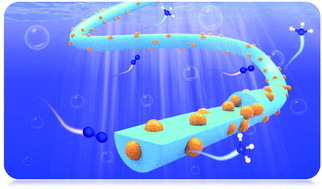Rigid anchoring of highly crystallized and uniformly dispersed Pd nanocrystals on carbon fibers for ambient electrocatalytic reduction of nitrogen to ammonia†
Abstract
Developing efficient and stable electrocatalysts for ammonia synthesis via the nitrogen reduction reaction (NRR) is essential for the Earth's nitrogen cycle. Herein, a palladium nanocrystals anchored carbon fibers (PdNCs@CNFs) composite was prepared via electrospinning and carbonization processes. X-ray diffraction (XRD), scanning electron microscopy (SEM) and transmission electron microscopy (TEM) characterization studies show that the as-prepared Pd grains are homogeneously anchored on the outer/inner section of the carbon nanofibers. Benefiting from the sufficient exposure and stress effect of active sites, the resultant PdNCs@CNFs achieves a high Faraday efficiency of ∼14.8% with a current density of 0.028 mA cm−2 at −0.2 V vs. reversible hydrogen electrode (RHE) in 0.1 M Na2SO4 solution, surpassing those of many catalysts previously reported. Density functional theory (DFT) calculations reveal that the rationality of the distal associative mechanism on PdNCs@CNFs and Pd nanocrystals on the surface of PdNCs@CNFs is more favorable for nitrogen (N2) molecule adsorption and polarization.



 Please wait while we load your content...
Please wait while we load your content...